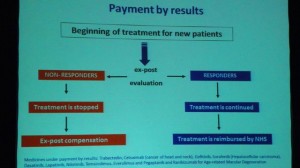Men with advanced prostate cancer want to know “if I take this drug, will I live longer?” Unfortunately, for abiraterone acetate (Zytiga®) in the pre-chemotherapy setting i.e for asymptomatic or mildly symptomatic men, doctors will only be able to say, “maybe” and tell the patient there is a strong trend towards an overall survival (OS) advantage.
You can read my Xconomy article published yesterday, on why I think it was a mistake for the abiraterone acetate COU-AA-302 trial (302 trial) in chemotherapy-naïve (pre-chemo) men to be stopped early. The results were presented on Saturday at the American Society of Clinical Oncology (ASCO) meeting in Chicago.
Understanding the Lan-DeMets alpha spending function with O’Brien-Fleming boundary based on number of death events observed is challenging for non-experts.
However, the bottom line is that the 302 trial failed to meet the pre-specified hazard ratio for stopping early, and by so doing it failed to meet one of its co-primary endpoints. This is disappointing because the trial most likely only needed another 92 deaths to occur before it would have reached significance, and this would have occurred in a matter of months.
The co-primary endpoint of radiographic progression free survival (rPFS) was, however, met in the 302 trial. Whether rPFS reflects tangible clinical benefit is unknown. The FDA have (to my knowledge) not approved a prostate cancer drug on the basis of rPFS , overall survival remains the regulatory standard.
I also learnt for the first time at ASCO about the problem of bone flare in patients receiving abiraterone. Charles Ryan, MD who presented the 302 data, discussed this is an ASCO educational session on prostate cancer imaging.
Bone scan flare is a spurious, “worsening” bone scan in the context of clinical response that reflects increased intensity of lesions, not new lesions. In other words a brighter image on a bone scan may not represent disease progression.
In a previously published study, Dr Ryan showed a 43% incidence (10/23) of bone flare with abiraterone. He advised attendees at the ASCO 2012 educational session to “look for, and CONFIRM new lesions before calling progression based solely on bone scans.”
Although the rPFS data for the COU-AA-302 trial was read centrally, and is therefore presumed to be more reliable as a result, I would have welcomed more discussion on the extent rPFS correlates with survival following the COU-AA-302 data presentation at ASCO. I expect the Oncologic Drugs Advisory Committee (ODAC) will vigorously discuss this in more detail when Johnson & Johnson seek a pre-chemotherapy indication for abiraterone based on the COU-AA-302 data.
Bearing in mind overall survival has been the de facto standard in advanced prostate cancer, it will be interesting to see how the FDA and ODAC will view what is essentially a failed trial with a non-significant OS. Will precedent be broken, opening the floodgates for future sponsor submissions based on PFS?
Update January 24 2013: FDA & EMA approve Zytiga Pre-Chemo in CRPC
With little fanfare and no ODAC, the FDA issued a press release on December 10, 2012 announcing that abiraterone acetate (Zytiga) had received approval “to treat men with late-stage (metastatic) castration-resistant prostate cancer prior to receiving chemotherapy.”
The press release states: “The FDA reviewed Zytiga’s application for this new indication under the agency’s priority review program. The program provides for an expedited six-month review for drugs that may offer major advances in treatment or provide a treatment when no adequate therapy exists.”
The fact that there was an unmet need for prostate cancer treatments prior to chemotherapy was clearly key to their decision making. The press release notes that “patients who received Zytiga had a median overall survival of 35.3 months compared with 30.1 months for those receiving the placebo.”
However, the FDA in their carefully worded press release make no mention of the fact that the difference of 5.2 months in median overall survival failed to reach the pre-specified value for statistical significance.
In other words, although JNJ have expanded the label for abiraterone to include the pre-chemo indication, they cannot make the claim that taking abiraterone prior to chemotherapy definitely results in men living longer (overall survival). All we can say is that the data was trending towards a statistically significant overall survival advantage. To many this may seem academic, but overall survival remains the benchmark that drives cancer drug development and by which treatment effectiveness is judged.
As I noted in my post from ASCO 2012 for Xconomy, most likely statistical significance for overall survival would have been reached in a few months, which is why I and others thought the trial had been stopped too early. I would be surprised if other companies follow JNJ’s strategy, and expect Medivation will seek to show a significant overall survival advantage for enzalatumide (Xtandi) in their pre-chemotherapy PREVAIL trial.
Johnson & Johnson announced on January 11, 2013 that abiraterone has also received approval in the European Union for the pre-chemotherapy prostate cancer indication following a positive recommendation from the Committee for Medical Products for Human Use (CHMP) of the European Medicines Agency (EMA).
It will be interesting to see if there is any new data in the updated interim analysis for the COU-AA-302 trial (abiraterone pre-chemo) that will be presented at the 2013 ASCO Genitourinary Cancers (ASCO GU) symposium in Orlando next month.
 Prostate cancer is the second leading cause of cancer death in men, so it was good news this morning when Medivation & Astellas issued a
Prostate cancer is the second leading cause of cancer death in men, so it was good news this morning when Medivation & Astellas issued a 
 One of the
One of the